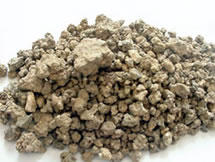
Wait?! What is montmorillonite?
And why is it in my raw meat patties for my dogs?
Here’s information pulled directly from Answers Pet Food:
| Answers Pet Food uses a unique form of Montmorillonite called AZOMITE®. AZOMITE® is unique silica clay that is mined in Utah from deposits left by an ancient volcano eruption that was ejected out of the side of a mountain and filled a nearby lake bed.This combination of seawater, fed by hundreds of rivers rich in minerals, and the rare and abundant minerals present in volcanic ash created the AZOMITE® deposit which is found nowhere else on Earth. The deposit is very old, perhaps as much as 30 million years. AZOMITE® does not contain bentonite clay but it does contain montmorillonite clay, it is mineralized, compacted volcanic ash containing minerals and trace elements. The idea of eating clay to promote internal healing will undoubtedly appear to many as farfetched, if not a little primitive. But natural clay, has not only been used medicinally for hundreds of years by indigenous cultures around the planet, but has, in recent years, been increasingly used by practitioners of alternative medicine as a simple but effective internal cleanser to help in preventing and alleviating various health problems. Montmorillonite clay – used by indigenous tribes and animals for centuries. Used for hundreds of years by native tribes around the globe, clay is one of the most effective natural intestinal detoxifying agents available. Primitive tribes have traditionally used various types of clay for conditions of toxicity. Dr. Weston A. Price in his book, “Nutrition and Physical Degeneration (1)“, stated that in studying the diets of native tribes he examined their knapsacks. Among the tribes examined in the high Andes, in Central Africa and the Aborigines of Australia, Dr. Price reported that some knapsacks contained balls of volcanic ash clay, a little of which was dissolved in water. The natives dipped pieces of food into the clay. Animals in the wild, drawn to clay deposits by instinct, have been observed licking the clay as part of their everyday diet, as well as rolling in it for relief from injuries. |
